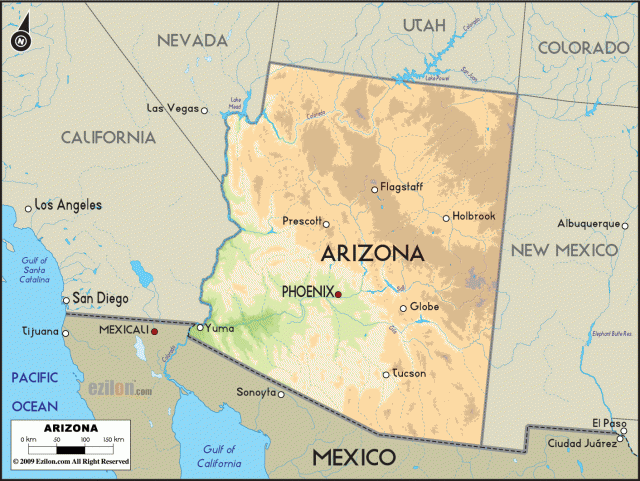The State of Arizona
AT A GLANCE
Name: Arizona comes from the Native American word Arizonac, which means “little spring” or “young spring.”
Nickname: Grand Canyon State
Capital: Phoenix
Size: 114,006 sq. mi.
Population: 6,731,000 (2014)
Statehood: Arizona became the 48th state on February 14, 1912.
Electoral votes: 11 (2016)
U.S. Representatives: 9 (until 2003)
State tree: paloverde
State flower: saguaro cactus blossom
State bird: cactus wren
Highest point: Humphreys Peak, 12,633 ft.

THE PLACE
Arizona is located in the southwestern region of the United States. Its northeastern corner forms part of the Four Corners, where Utah, Colorado, New Mexico, and Arizona meet. Four Corners is the only place in the United States where a person can simultaneously stand in four different states.
Much of Arizona consists of desert, including the famous Painted and Sonoran Deserts. These regions have a dry climate that is hot in the summer and warm in the winter. Many of these areas are irrigated with water from Arizona's large rivers, including the Colorado River, and the lands are used for farming.
Other areas of Arizona are mountainous and are home to some of the largest ponderosa pine forests in the United States. The climate is cooler in these parts of the state. Arizona has large deposits of minerals, including gold, silver, and copper.
Facts and Firsts
- Arizona has the third-largest Native American population in the United States.
- Kykotsmovi is believed to be the oldest inhabited village in the United States. The Hopi people built this settlement during the 1100s.
- Tucson, the astronomy capital of the world, has more telescopes than anyplace else. The largest solar telescope in the world is located in Kitt Peak National Observatory in Sells.
- Arizona is the home of some of the country's most famous landmarks, including Grand Canyon National Park, the Painted Desert, the Petrified Forest, and the Sonoran (or Gila) Desert.
- Arizona produces more copper than any other state; the copper covering atop the Arizona state capitol building is equivalent to 4.8 million pennies.
THE PAST
Human remains dating back about 12,000 years have been found in Arizona. Many native civilizations flourished there, including the Hohokam and the Anasazi, who built complex cliff dwellings between 1100 and 1300. Apache and Navajo peoples migrated to Arizona during the 1400s.
Spanish explorers first arrived in 1539. Franciscan friar Marcos de Niza was the first Spaniard to visit Arizona in his search for the mythical Seven Cities of Cibola. A year later, explorer Francisco Vasquez de Coronado arrived. In the following years, Spanish missionaries settled the land.
As part of Mexico, Arizona remained under Spanish rule until Mexico was granted independence from Spain in 1821. In 1848, after the Mexican War, the United States won most of Arizona from Mexico. The United States bought the rest of the territory in 1853 as part of the Gadsden Purchase.
Once the territory became part of the United States, several wars broke out between frontiersmen and Native Americans. These wars did not end until 1886, when Apache leader Geronimo surrendered. The territory became a state on February 14, 1912.
THE PRESENT
When Spanish explorers first arrived in Arizona in the 16th century, they found a dry region that was covered with deserts and mesas. Today, Arizona is a modern, industrial state that manufactures many electrical, communications, and aeronautical items.
Irrigation from Arizona's large rivers, including the Colorado, has transformed some of the state's desert regions into rich farmland. Cotton, vegetables, and sorghum are important crops. In the mountainous regions, farmers raise cattle and sheep.
Arizona's scenery, landmarks, and warm climate make it a popular tourist destination. The Grand Canyon, the Painted Desert, and the Petrified Forest attract thousands of people each year. The state's rich heritage and history also attract visitors.
Born in Arizona
- Lynda Carter, actress
- Cesar Chavez, labor leader
- Cochise, Apache chief
- Geronimo (Goyathlay), Apache leader
- Barry Goldwater, politician
- Charles Mingus, jazz musician and composer
- Carlos Montezuma, doctor and Native American spokesman
- Stevie Nicks, singer
- Linda Ronstadt, singer
- Kerri Strug, gymnast